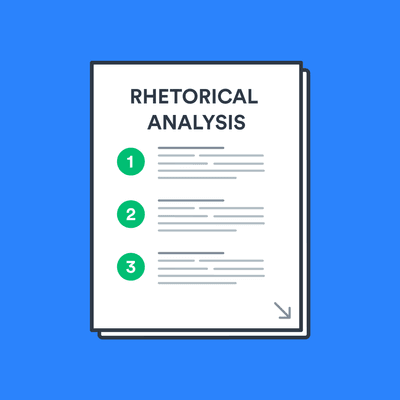How to write a rhetorical analysis

What is a rhetorical analysis?
Rhetoric is the art of persuasion and aims to study writers’ or speakers' techniques to inform, persuade, or motivate their audience. Thus, a rhetorical analysis aims to explore the goals and motivations of an author, the techniques they’ve used to reach their audience, and how successful these techniques were.
This will generally involve analyzing a specific text and considering the following aspects to connect the rhetorical situation to the text:
- Does the author successfully support the thesis or claims made in the text? Here, you’ll analyze whether the author holds to their argument consistently throughout the text or whether they wander off-topic at some point.
- Does the author use evidence effectively considering the text’s intended audience? Here, you’ll consider the evidence used by the author to support their claims and whether the evidence resonates with the intended audience.
- What rhetorical strategies the author uses to achieve their goals. Here, you’ll consider the word choices by the author and whether these word choices align with their agenda for the text.
- The tone of the piece. Here, you’ll consider the tone used by the author in writing the piece by looking at specific words and aspects that set the tone.
- Whether the author is objective or trying to convince the audience of a particular viewpoint. When it comes to objectivity, you’ll consider whether the author is objective or holds a particular viewpoint they want to convince the audience of. If they are, you’ll also consider whether their persuasion interferes with how the text is read and understood.
- Does the author correctly identify the intended audience? It’s important to consider whether the author correctly writes the text for the intended audience and what assumptions the author makes about the audience.
- Does the text make sense? Here, you’ll consider whether the author effectively reasons, based on the evidence, to arrive at the text’s conclusion.
- Does the author try to appeal to the audience’s emotions? You’ll need to consider whether the author uses any words, ideas, or techniques to appeal to the audience’s emotions.
- Can the author be believed? Finally, you’ll consider whether the audience will accept the arguments and ideas of the author and why.
Summing up, unlike summaries that focus on what an author said, a rhetorical analysis focuses on how it’s said, and it doesn’t rely on an analysis of whether the author was right or wrong but rather how they made their case to arrive at their conclusions.
Although rhetorical analysis is most used by academics as part of scholarly work, it can be used to analyze any text including speeches, novels, television shows or films, advertisements, or cartoons.
What are the key concepts of a rhetorical analysis?
Now that we’ve seen what rhetorical analysis is, let’s consider some of its key concepts.
Rhetorical Situation
Any rhetorical analysis starts with the rhetorical situation which identifies the relationships between the different elements of the text. These elements include the audience, author or writer, the author’s purpose, the delivery method or medium, and the content:
- Audience: The audience is simply the readers of a specific piece of text or content or printed material. For speeches or other mediums like film and video, the audience would be the listeners or viewers. Depending on the specific piece of text or the author’s perception, the audience might be real, imagined, or invoked. With a real audience, the author writes to the people actually reading or listening to the content while, for an imaginary audience, the author writes to an audience they imagine would read the content. Similarly, for an invoked audience, the author writes explicitly to a specific audience.
- Author or writer: The author or writer, also commonly referred to as the rhetor in the context of rhetorical analysis, is the person or the group of persons who authored the text or content.
- The author’s purpose: The author’s purpose is the author’s reason for communicating to the audience. In other words, the author’s purpose encompasses what the author expects or intends to achieve with the text or content.
- The medium: The medium is the delivery method used by the author to deliver the content to the audience. Depending on the specific type of text, the medium can differ and include, for example:
- Alphabetic text includes essays, editorials, articles, speeches, and other written pieces.
- Imaging includes website and magazine advertisements, TV commercials, and the like.
- Audio includes speeches, website advertisements, radio or tv commercials, or podcasts.
- Context: The context of the text or content considers the time, place, and circumstances surrounding the delivery of the text to its audience. With respect to context, it might often also be helpful to analyze the text in a different context to determine its impact on a different audience and in different circumstances.
Claims, Supports, and Warrants
An author will use claims, supports, and warrants to build the case around their argument, irrespective of whether the argument is logical and clearly defined or needs to be inferred by the audience:
- Claim: The claim is the main idea or opinion of an argument that the author must prove to the intended audience. In other words, the claim is the fact or facts the author wants to convince the audience of. Claims are usually explicitly stated but can, depending on the specific piece of content or text, be implied from the content. Although these claims could be anything and an argument may be based on a single or several claims, the key is that these claims should be debatable.
- Support: The supports are used by the author to back up the claims they make in their argument. These supports can include anything from fact-based, objective evidence to subjective emotional appeals and personal experiences used by the author to convince the audience of a specific claim. Either way, the stronger and more reliable the supports, the more likely the audience will be to accept the claim.
- Warrant: The warrants are the logic and assumptions that connect the supports to the claims. In other words, they’re the assumptions that make the initial claim possible. The warrant is often unstated, and the author assumes that the audience will be able to understand the connection between the claims and supports. In turn, this is based on the author’s assumption that they share a set of values and beliefs with the audience that will make them understand the connection mentioned above. Conversely, if the audience doesn’t share these beliefs and values with the author, the argument will not be that effective.
Appeals
Appeals are used by authors to convince their audience and, as such, are an integral part of the rhetoric and are often referred to as the rhetorical triangle. As a result, an author may combine all three appeals to convince their audience:
- Ethos: Ethos represents the authority or credibility of the author. To be successful, the author needs to convince the audience of their authority or credibility through the language and delivery techniques they use. This will, for example, be the case where an author writing on a technical subject positions themselves as an expert or authority by referring to their qualifications or experience.
- Logos: Logos refers to the reasoned argument the author uses to persuade their audience. In other words, it refers to the reasons or evidence the author proffers in substantiation of their claims and can include facts, statistics, and other forms of evidence. For this reason, logos is also the dominant approach in academic writing where authors present and build up arguments using reasoning and evidence.
- Pathos: Through pathos, also referred to as the pathetic appeal, the author attempts to evoke the audience’s emotions through the use of, for instance, passionate language, vivid imagery, anger, sympathy, or any other emotional response.
How to write a rhetorical analysis
To write a rhetorical analysis, you need to follow the steps below:
Step 1: Plan and prepare
With a rhetorical analysis, you don’t choose concepts in advance and apply them to a specific text or piece of content. Rather, you’ll have to analyze the text to identify the separate components and plan and prepare your analysis accordingly.
Here, it might be helpful to use the SOAPSTone technique to identify the components of the work. SOAPSTone is a common acronym in analysis and represents the:
- Speaker. Here, you’ll identify the author or the narrator delivering the content to the audience.
- Occasion. With the occasion, you’ll identify when and where the story takes place and what the surrounding context is.
- Audience. Here, you’ll identify who the audience or intended audience is.
- Purpose. With the purpose, you’ll need to identify the reason behind the text or what the author wants to achieve with their writing.
- Subject. You’ll also need to identify the subject matter or topic of the text.
- Tone. The tone identifies the author’s feelings towards the subject matter or topic.
Apart from gathering the information and analyzing the components mentioned above, you’ll also need to examine the appeals the author uses in writing the text and attempting to persuade the audience of their argument. Moreover, you’ll need to identify elements like word choice, word order, repetition, analogies, and imagery the writer uses to get a reaction from the audience.
Once you’ve gathered the information and examined the appeals and strategies used by the author as mentioned above, you’ll need to answer some questions relating to the information you’ve collected from the text. The answers to these questions will help you determine the reasons for the choices the author made and how well these choices support the overall argument.
Here, some of the questions you’ll ask include:
- What was the author’s intention?
- Who was the intended audience?
- What is the author’s argument?
- What strategies does the author use to build their argument and why do they use those strategies?
- What appeals the author uses to convince and persuade the audience?
- What effect the text has on the audience?
Keep in mind that these are just some of the questions you’ll ask, and depending on the specific text, there might be others.
Step 2: Write your introduction
Once you’ve done your preparation, you can start writing the rhetorical analysis. It will start off with an introduction which is a clear and concise paragraph that shows you understand the purpose of the text and gives more information about the author and the relevance of the text.
The introduction also summarizes the text and the main ideas you’ll discuss in your analysis. Most importantly, however, is your thesis statement. This statement should be one sentence at the end of the introduction that summarizes your argument and tempts your audience to read on and find out more about it.
Step 3: Write the body
After your introduction, you can proceed with the body of your analysis. Here, you’ll write at least three paragraphs that explain the strategies and techniques used by the author to convince and persuade the audience, the reasons why the writer used this approach, and why it’s either successful or unsuccessful.
You can structure the body of your analysis in several ways. For example, you can deal with every strategy the author uses in a new paragraph, but you can also structure the body around the specific appeals the author used or chronologically.
No matter how you structure the body and your paragraphs, it’s important to remember that you support each one of your arguments with facts, data, examples, or quotes and that, at the end of every paragraph, you tie the topic back to your original thesis.
Step 4: Write your conclusion
Finally, you’ll write the conclusion of your rhetorical analysis. Here, you’ll repeat your thesis statement and summarize the points you’ve made in the body of your analysis. Ultimately, the goal of the conclusion is to pull the points of your analysis together so you should be careful to not raise any new issues in your conclusion.
After you’ve finished your conclusion, you’ll end your analysis with a powerful concluding statement of why your argument matters and an invitation to conduct more research if needed.
Frequently Asked Questions about rhetorical analysis
💚 What is the purpose of rhetorical analysis?
A rhetorical analysis aims to explore the goals and motivations of an author, the techniques they’ve used to reach their audience, and how successful these techniques were. Although rhetorical analysis is most used by academics as part of scholarly work, it can be used to analyze any text including speeches, novels, television shows or films, advertisements, or cartoons.
🏞️ What are the steps to write a rhetorical analysis?
The steps to write a rhetorical analysis include:
- Step 1: Plan and prepare
- Step 2: Write your introduction
- Step 3: Write the body
- Step 4: Write your conclusion
🐧 How do you write a rhetorical analysis introduction?
Your rhetorical analysis introduction is a clear and concise paragraph that shows you understand the purpose of the text and gives more information about the author and the relevance of the text. The introduction also summarizes the text and the main ideas you’ll discuss in your analysis.
🥃 What is ethos in rhetorical analysis?
Ethos represents the authority or credibility of the author. To be successful, the author needs to convince the audience of their authority or credibility through the language and delivery techniques they use. This will, for example, be the case where an author writing on a technical subject positions themselves as an expert or authority by referring to their qualifications or experience.
🛗 What are the 3 types of appeals in rhetorical analysis?
Appeals are used by authors to convince their audience and, as such, are an integral part of the rhetoric and are often referred to as the rhetorical triangle. The 3 types of appeals are ethos, logos, and pathos.


